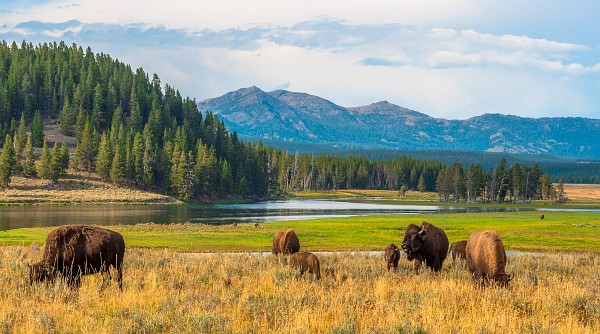Yellowstone, America’s first national park is big — 2.2 million acres. In addition to its size, Yellowstone divides into distinctly different regions and habitats that include geysers, fumaroles, and other geothermal features plus a canyon, a lake, and a series of limestone terraces as well as an abundance of roaming wildlife. With such vastness and variety, the park can be overwhelming. When you visit Yellowstone National Park, follow these insider tips to make the most of your vacation.
1. Pack for Multiple Seasons
Even in summer, low temperatures at night can become quite cold, and daytime highs shoot into the 80s. Dress in layers so you can remove clothing items if it becomes too warm, and be sure to pack a jacket or coat, and perhaps some warm socks for evenings.
2. Stop at the Visitor Centers
The best way to visit Yellowstone starts with visitor centers. Each facility presents educational exhibits that focus on their particular region of the park. While at the centers, check for the ranger programs.
3. Stay a Safe Distance From Wildlife
Stay a safe distance from wildlife. If you want to see what a bison or elk looks like up close, view them through your binoculars or via the zoom feature on your camera or phone. The park requires that visitors stay 100 yards—the length of a football field— away from bears, wolves, and nesting birds, and 25 yards from all other wildlife. Even if you are the legal distance from an animal, watch their behavior – if they change what they’re doing as a result of your movements, you’re too close.
Your best chance of spotting the park’s legendary bison as well as other critters is in the early morning or evening. Check out The Yellowstone National Park Service article here for more tips on wildlife viewing. But once again, note that bison may look docile as they’re peacefully grazing, but they are NOT. Incidents are on the rise regarding park-goers getting far too close and being gored by these potentially dangerous animals. So again – KEEP YOUR DISTANCE!
4. Visit Yellowstone Lake in the Afternoon
While the day visitors view Old Faithful and the surrounding area, head to 136-square-mile Yellowstone Lake, the largest in the park. Consider signing up for a guided boat tour or rent a boat on your own.
5. See Old Faithful in the Early Morning or in the Evening
Almost everyone who enters the park heads to Old Faithful first. For a more intimate experience visiting Old Faithful, explore the Upper Geyser Basin in the early morning before the day visitors arrive or in the late afternoon after they leave.
6. Take a Hike
Seeing Yellowstone shouldn’t be limited to marveling at wonders through your car window. One of the best ways to see Yellowstone is to hit the trails. Walking even a ½ mile on a boardwalk or trail offers you a more complete sense of Yellowstone’s features and landscape.
7. Explore Lamar Valley
Often less-visited than other areas, Lamar Valley’s habitat draws wildlife and the open vistas create optimum viewing conditions. You may see elk, bear, coyote, bighorn sheep, and eagles, especially if you arrive early. Consider booking the park’s early-morning Wake Up to Wildlife Tour.
8. Look at the Stars
Go outside after dark. Walk 100 yards from your lodge or drive a short distance to a turnout, then park, scan the lot for wildlife, and if none is present, exit your car to look up at the dazzling display of stars. With so little light pollution, the night sky is a wonder.
However, if you plan to be out at night, it is worth noting that the park keeps the lights low and soft. So, bring a flashlight for comfort, especially when traveling with young children.
Source: Yellowstone National Park – Candyce H. Stapen


